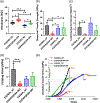A novel methacrylate derivative polymer that resists bacterial cell-mediated biodegradation
- PMID: 34855282
- PMCID: PMC10311470
- DOI: 10.1002/jbm.b.34972
A novel methacrylate derivative polymer that resists bacterial cell-mediated biodegradation
Abstract
This study tests biodegradation resistance of a custom synthesized novel ethylene glycol ethyl methacrylate (EGEMA) with ester bond linkages that are external to the central polymer backbone when polymerized. Ethylene glycol dimethacrylate (EGDMA) with internal ester bond linkages and EGEMA discs were prepared in a polytetrafluoroethylene (PTFE) mold using 40 μl macromer and photo/co-initiator mixture cured for 40 s at 1000 mW/cm2 . The discs were stored in the constant presence of Streptococcus mutans (S. mutans) in Todd Hewitt Yeast + Glucose (THYE+G) media up to 9 weeks (n = 8 for each macromer type) and physical/mechanical properties were assessed. Initial measurements EGEMA versus EGDMA polymer discs showed equivalent degree of conversion (45.69% ± 2.38 vs. 46.79% ± 4.64), diametral tensile stress (DTS; 8.12± 2.92 MPa vs. 6.02 ± 1.48 MPa), and low subsurface optical defects (0.41% ± 0.254% vs. 0.11% ± 0.074%). The initial surface wettability (contact angle) was slightly higher (p ≤ .012) for EGEMA (62.02° ± 3.56) than EGDMA (53.86° ± 5.61°). EGDMA showed higher initial Vicker's hardness than EGEMA (8.03 ± 0.88 HV vs. 5.93 ± 0.69 HV; p ≤ .001). After 9 weeks of S. mutans exposure, EGEMA (ΔDTS-1.30 MPa) showed higher resistance to biodegradation effects with a superior DTS than EGDMA (ΔDTS-6.39 MPa) (p = .0039). Visible and scanning electron microscopy images of EGEMA show less surface cracking and defects than EGDMA. EGDMA had higher loss of material (18.9% vs. 8.5%, p = .0009), relative changes to fracture toughness (92.5% vs. 49.2%, p = .0022) and increased water sorption (6.1% vs. 1.9%, p = .0022) compared to EGEMA discs. The flipped external ester group linkage design is attributed to EGEMA showing higher resistance to bacterial degradation effects than an internal ester group linkage design methacrylate.
Keywords: biodegradation; dental/craniofacial material; mechanical; polymerization; properties.
© 2021 Wiley Periodicals LLC.
Conflict of interest statement
CONFLICT OF INTEREST
Bob Bolskar is a senior research chemist at TDA Research. All co-authors may potentially be named on a TDA Research/University of Minnesota patent application.
Figures






References
Publication types
MeSH terms
Substances
Grants and funding
LinkOut - more resources
Full Text Sources

